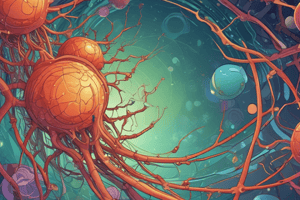Podcast
Questions and Answers
What is the primary function of the adaptive immune system in response to foreign antigen exposure?
What is the primary function of the adaptive immune system in response to foreign antigen exposure?
- To enhance its ability to respond again to that antigen (correct)
- To eliminate the immune response
- To reduce the immune response to subsequent exposure
- To inhibit the immune response
What is the characteristic of the secondary immune response?
What is the characteristic of the secondary immune response?
- Slower and weaker than the primary immune response
- Variable response
- Similar to the primary immune response
- Faster and stronger than the primary immune response (correct)
What type of cells is responsible for cellular immunity?
What type of cells is responsible for cellular immunity?
- Macrophages
- Accessory cells
- B cells
- T cells (correct)
What is the term for the process of returning the immune system to its resting or basal state after antigen stimulation?
What is the term for the process of returning the immune system to its resting or basal state after antigen stimulation?
What is the primary difference between innate and adaptive immunity?
What is the primary difference between innate and adaptive immunity?
What occurs when the innate immune system fails to combat an infection?
What occurs when the innate immune system fails to combat an infection?
What is the role of accessory cells in the adaptive immune system?
What is the role of accessory cells in the adaptive immune system?
What is the result of the interaction between the innate and adaptive immune systems?
What is the result of the interaction between the innate and adaptive immune systems?
What is the characteristic of adaptive immunity that allows for specific defense against repeated infections?
What is the characteristic of adaptive immunity that allows for specific defense against repeated infections?
What is the outcome of the adaptive immune response to a second infection with the same organism?
What is the outcome of the adaptive immune response to a second infection with the same organism?
Flashcards are hidden until you start studying
Study Notes
Immunity System Overview
- Immunity is a state of protection from infectious diseases.
- The immune system is a versatile defense system that protects animals from invading pathogenic microorganisms and cancer.
- It generates a variety of cells and molecules capable of specifically recognizing and eliminating foreign invaders.
Innate Immunity
- Innate immunity is an immediate response to pathogens and represents the first line of defense.
- It is not directed against any particular pathogen and lacks immunologic memory.
- Components of innate immunity include:
- Anatomical barriers (skin, epithelium, and mucous membranes)
- Humoral components (complement, coagulation system, cytokines, lysozymes, and lactoferrin)
- Cellular components (neutrophils, monocytes, macrophages, NK cells, and eosinophils)
Physiological Barriers
- Skin: few microorganisms can penetrate intact skin, but many can enter through sweat or sebaceous glands and hair follicles.
- Mucous membranes: bacteria tend to stick to a film of mucous, which is constantly being driven upward by ciliated cells toward the natural orifices.
Mechanisms of Innate Immunity
- Cellular components:
- Phagocytic leukocytes (phagocytosis and intracellular killing)
- Macrophages (phagocytosis, intracellular killing, extracellular killing, tissue repair, and antigen presentation)
- NK cells and eosinophils (killing of virus-infected and altered self targets, and killing of certain parasites)
- Humoral components:
- Complement (lysis of bacteria and some viruses, opsonin, increase in vascular permeability, and recruitment of phagocytic cells)
- Coagulation system (increase in vascular permeability and recruitment of phagocytic cells)
- Lactoferrin and transferrin (compete with bacteria for iron)
- Cytokines (various effects)
Phagocytosis
- Phagocytosis involves:
- Extension of pseudopodia to engulf foreign material
- Fusion of pseudopodia to trap the material in a phagosome
- Fusion of the phagosome with a lysosome to create a phagolysosome
- Digestion
- Exocytosis of digested contents
- Phagocytic cells increase in number during infections, and their main functions include chemotaxis, migration, ingestion, and microbial killing.
Adaptive Immunity
- Adaptive immunity is specific, repeated exposure leads to augmented memory, and responses are faster, more vigorous, and longer-lasting.
- Components of adaptive immunity include:
- Cells (cell-mediated immunity)
- Soluble factors (humoral immunity)
Cardinal Features of Adaptive Immune Responses
- Specificity: individual lymphocytes express membrane receptors that distinguish subtle differences in structure between distinct antigens.
- Diversity: the lymphocyte repertoire can discriminate 10^9 to 10^11 distinct antigens.
- Memory: exposure to foreign antigen enhances the immune system's ability to respond again to that antigen.
Interactions between Innate and Adaptive Immunity
- Innate immunity holds off disease until adaptive immunity develops specific memory.
- Failure of innate immunity leads to disease, and adaptive immunity provides recovery and specific memory against second infections.
Studying That Suits You
Use AI to generate personalized quizzes and flashcards to suit your learning preferences.




